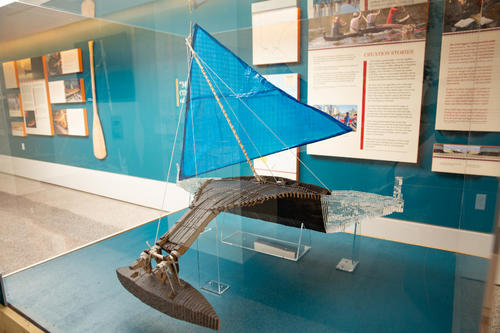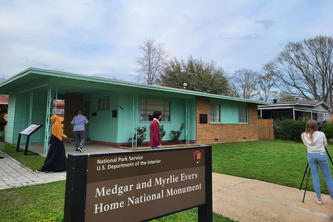
Canoes are one of the oldest and still most widely used global Indigenous technologies. Their functionality and cultural significance allow them to be vessels for transportation, a positive foundation for building relationships, and a teaching and learning space. Canoes are also a strong cultural symbol with ties to Traditional Ecological Knowledge and environmental stewardship.
“This exhibit is a representation of the ongoing relationship building and knowledge exchange between three Indigenous communities around Mnisota Makoce,” said Jacob Bernier, a Red River Métis descendant who grew up in St. Paul, a graduate student in Heritage Studies and Public History (HSPH) in the College of Design and is one of the exhibit’s two Indigenous student curators. “These are canoe communities. The focus on revitalizing canoe traditions and the continuance of these ways of knowing is important to future generations. These traditional ways were interrupted, and nearly lost, due to multiple assaults of colonization. As Mat Pendleton from the Lower Sioux Indian community says, the rivers were highways and byways for Indigenous people. Revitalizing these practices is central to identity.”
Bernier worked with other University students and faculty after being inspired by undergraduate coursework in American Indian Studies with U of M Professor Vicente Diaz and student group Canoe Rising.
“Why Canoes: Capacious Vessels and Indigenous Futures of Minnesota's Peoples and Places” opened at Northrop's fourth-floor gallery exploring the interconnectedness between the Native Canoe Program, University of Minnesota students, faculty, staff, and members of three Indigenous communities around Mni Sota Makoce (Minnesota). The exhibit consists of interviews, images, physical objects, and interactive components for the public.
{"preview_thumbnail":"/sites/twin-cities.umn.edu/files/styles/video_embed_wysiwyg_preview/public/video_thumbnails/yARV1rJkv8w.jpg?itok=6Hi3QymD","video_url":"https://youtu.be/yARV1rJkv8w","settings":{"responsive":1,"width":"854","height":"480","autoplay":0},"settings_summary":["Embedded Video (Responsive)."]}
“This exhibit is an exploration and celebration of relationships between the Dakota, Ojibwe and Micronesian communities that have come together and found a common passion for sharing water traditions,” said Vicente M. Diaz, a professor in American Indian Studies in the College of Liberal Arts and director of The Native Canoe Program. “This exhibit also helps broaden the understanding of the waters that surround us through the resurgence and revitalization of canoe communities. We are grateful for their knowledge and partnership."
“Celebrating our Indigenous culture through this exhibit at Northrop is an important way to recognize the rich impact native cultures have on our everyday lives,” said Tadd Johnson, University's senior director of American Tribal Nations Relations.
Exhibit Details
Cost: Free
Hours: noon to 5 p.m., Monday - Friday
Northrop’s safety guidelines
-30-
“Why Canoes?” was developed in coordination with a group of campus and community advisors, including representatives from the featured communities. The curatorial team consists of Bernier and former U of M student Chrissy Goodwin. The exhibit is co-presented by Northrop, the College of Design’s HSPH program, and the Institute for Advanced Study and funded by the U of M Imagine Fund and The Andrew W. Mellon Foundation.
Contact Kat Dodge at [email protected] for multimedia assets of the exhibit.





